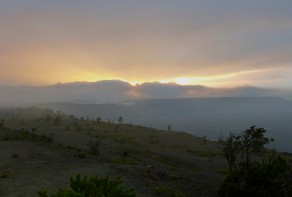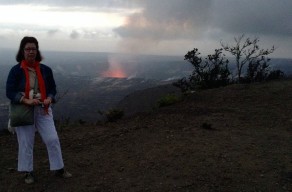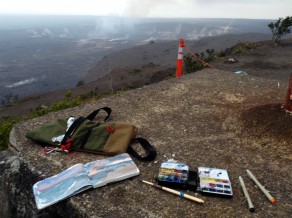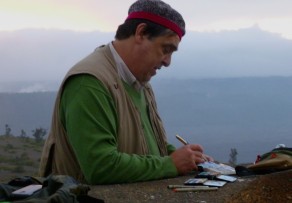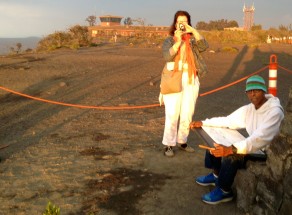Returning to our barracks, we agreed to rise around 4:30 and resume our toils at the crater.
Taking a glass from the kitchen I tossed a few ice cubes in it, covered them with an ounce or two of Jameson’s, drained it and fell into bed. In a minute I was unconscious. Then Kathie woke me. I looked at the clock. It read 4:45.
Someone’s moving around, she said. Don’t you have to go back out there?
As I pulled on my clothes I suggested that she come along to watch the dawn break over the caldera. Within minutes we were outside by the van. Mike drove us and a few others back to the Jaggar, from whence we made our way back to the summit.
It was still dark but a rosy grey band divided the land from the hovering clouds off to the south. I unpacked my kit and set to work, while Kathie photographed the proceedings. The previous night had been enough of a rehearsal for me to go off book, as they say in the theatre. I worked rapidly, producing three page spreads of Halema’uma’u as the new day arrived, until sunlight extinguished the pit’s glow.
I find that landscape painting in watercolor allows for less literal interpretations than working in oils. Quick washes and pairings of complementary colors establish an armature of light. Notes are struck and answered until a pattern emerges, at which point one might judge a work complete, or proceed to elaborate it. I seldom attempt refinements in the field because conditions are in constant flux. Better to let the work rest for a few hours or a few days before trusting memory and sound design to guide the process.
During the late 19th century, a younger generation of artists inspired by expeditionary artists like William Hodges, T.R. Peale, Albert Bierstadt and Thomas Moran, produced bodies of work around the theme of the Hawaiian volcanoes.
Known today as the Volcano School, notably Jules Tavernier and his protege David Howard Hitchcock. They attempted to do for what were then known as the Sandwich Islands what Thomas Cole and Asher B. Durand had done for the Hudson Valley. In many ways they pioneered a picturesque esthetic later embraced by shutterbug tourism.
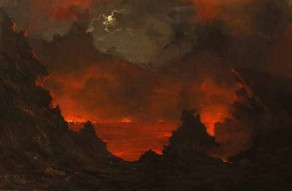
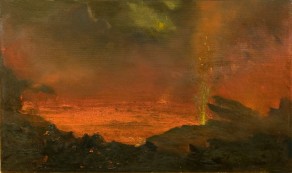
There was some resonance for us being at Kilauea together because Kathie and I had first met at a conference on scientific exploration at the American Philosophical Society, where she was a one of the speakers. Her Columbia doctoral dissertation and late her first book was on 19th century American artists-travelers in Latin America. Some of Peale’s expeditionary watercolors are in the APS collection. At the time we first met I had been painting Civil War battlefields that were threatened with desecration or obliteration. I had rejected the notion of landscape painting based on formal motifs when I discovered that landscape is a narrative constructed by human beings repurposing the natural conditions of terrain to suit their convenience. This was an oversight I attributed to the deficiencies of a studio education. Expeditionary art had been created not only to document the process of exploration, but also to provide military leaders and scientists with a sales pitch for the next adventure. Surveys of the American West mapped railroad rights of way and searched for mineral resources. While places like the Yosemite, Yellowstone and the Grand Canyon yielded nothing of material value, they became gold mines for the growing tourism industry. The same was true of Kilauea. The first hotel was built near the rim in the 1840s. A more permanent structure went up in 1866, which now houses the Volcano Art Center. Mark Twain had been one of its guests. The latest incarnation of Volcano House was built in the 20th century. Offering quality accommodations, fine dining, an array of galleries and gift shops at a substantial nightly rate, the rear seating area of the lobby opens onto a broad belvedere of the crater.
Mike was seated on the opposite side of the monument, working on a drawing. Moses stood at his easel, visible in this photograph a hundred yards to the rear, close to the museum. A few of the students still lingered at the site. Rosella and all but one of her posse had stumbled back to KMC around 3am. The straggler had returned but at such a late hour gave no notice. Lacking hot coffee with stomachs grumbling, our merry band descended to the parking lot, returned to the barracks and prepared a hot breakfast. The charismatic Moses was already recruiting doughty souls for a crater hike, an invitation we politely declined.
Instead, Kathie and I decided to explore the South Point area and Puna’lu’u Beach.
(To be continued)
